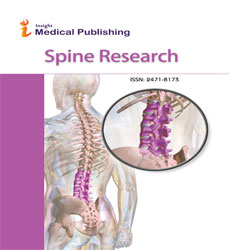Editorial Note on Ligamentum Flavum
Sharadha K
DOI10.36648/2471-8173.21.7.26
Department of Microbiology, Jawaharlal Nehru Technological University, Hyderabad, Telangana, India
- Corresponding Author:
- Sharadha S
Department of Microbiology
Jawaharlal Nehru Technological University
Hyderabad, Telangana, India
Tel: 9177390873
E-mail: katravathsharadha8@gmail.com
Received Date: July 15, 2021; Accepted Date: July 20, 2021; Published Date: July 25, 2021
Citation: Sharadha K (2021) Editorial Note on Ligamentum Flavum. Spine Res. Vol.7 No.4:26.
Editorial
Solidification of the ligamentum flavum (OLF) is a sickness of ectopic bone arrangement inside the ligamentum flavum, which may bring about mass impact and neurological trade off. The low thoracic area is the most well-known district of event, and this is trailed by the cervical, then, at that point lumbar, spine. The predominance of OLF is altogether higher in the Japanese populace contrasted and different identities and has a male prevalence. Solidification of the ligamentum flavum has been accounted for in relationship with the more normal ligamentous neurotic elements—hardening of the back longitudinal tendon and diffuse idiopathic skeletal hyperostosis. These last two conditions have been connected to a few metabolic cycles, and a potential hereditary premise has been theorized. Here, the creators present a one of a kind instance of OLF of the cervical spine in a patient with idiopathic hypercalcemia.
The clinical condition is hard to separate from lumbosacral or sacro-iliac issues, and lipiodol examines are needed to arrive at a last determination. It is only occasionally conceivable to separate the imperfections in the segment of lipiodol from those created by break of an intervertebral plate. Pressure of nerve roots by the broadened tendon delivers the side effects and signs. After their exit from the dura, the nerve establishes lie in the exceptionally restricted space between the ligamentum flavum and the intervertebral circle. Indeed, even a slight expansion of the tendon, a back distension of the intervertebral circle, or a blend of the two, will deliver pressure of the nerve roots.
The Ligamentum flavum (LF) hypertrophy is the typical reason for the lumbar spinal stenosis and it is believed to be degenerationdriven. Formative spinal stenosis (DSS) is portrayed by previous limited spinal waterways and is possible a formative issue that happens in adolescence. In these cases, the LF may exhibit various qualities when contrasted with degeneration-driven stenosis. Consequently, this examination expected to explore the connection between histological changes of LF and trench size.
Degenerative changes in back components of the spine, for example, thickening or hypertrophy of the ligamentum flavum (LF) may bring about spinal stenosis. In the current examination, we intended to explore the potential variables including age, intervertebral circle degeneration (IDD), feature joint degeneration (FJD), end plate degeneration (EPD), which may influence LF thickening and to uncover the relationship among those elements at each degree of lumbar spine by assessing the attractive reverberation pictures (MRI).
The ligamentum flavum replaces the joint case anteriorly and medially. As talked about, this tendon passes from the front and mediocre part of the lamina of the vertebra above to the back and prevalent part of the lamina of the vertebra beneath. Notwithstanding, the horizontal filaments of this tendon course foremost to the Z joint, connect to its edges, and structure its front case. Synovial augmentations, or growths, jut out of the Z joint and along the connection destinations of the ligamentum flavum to the nearby prevalent and substandard articular cycles.
Open Access Journals
- Aquaculture & Veterinary Science
- Chemistry & Chemical Sciences
- Clinical Sciences
- Engineering
- General Science
- Genetics & Molecular Biology
- Health Care & Nursing
- Immunology & Microbiology
- Materials Science
- Mathematics & Physics
- Medical Sciences
- Neurology & Psychiatry
- Oncology & Cancer Science
- Pharmaceutical Sciences
